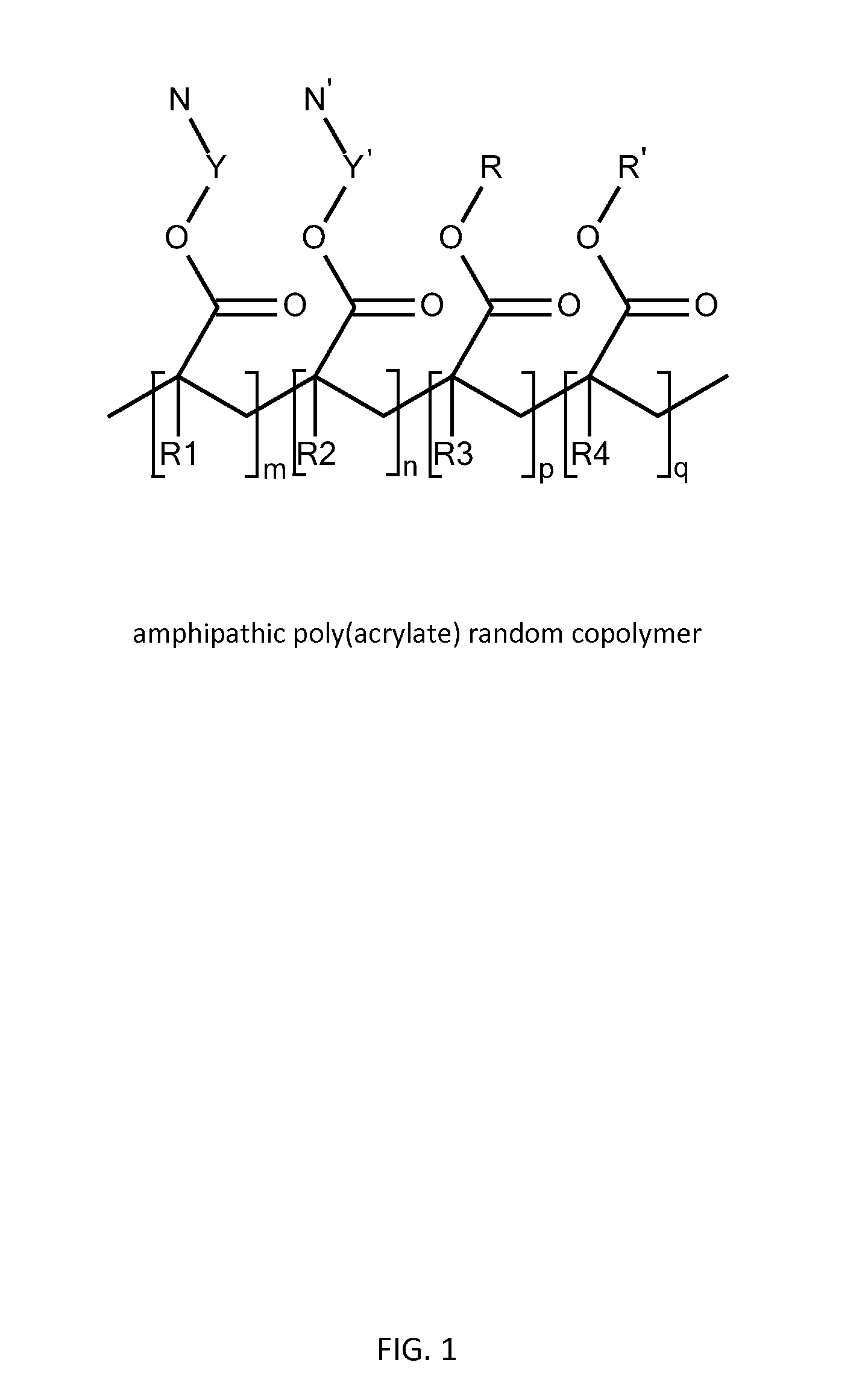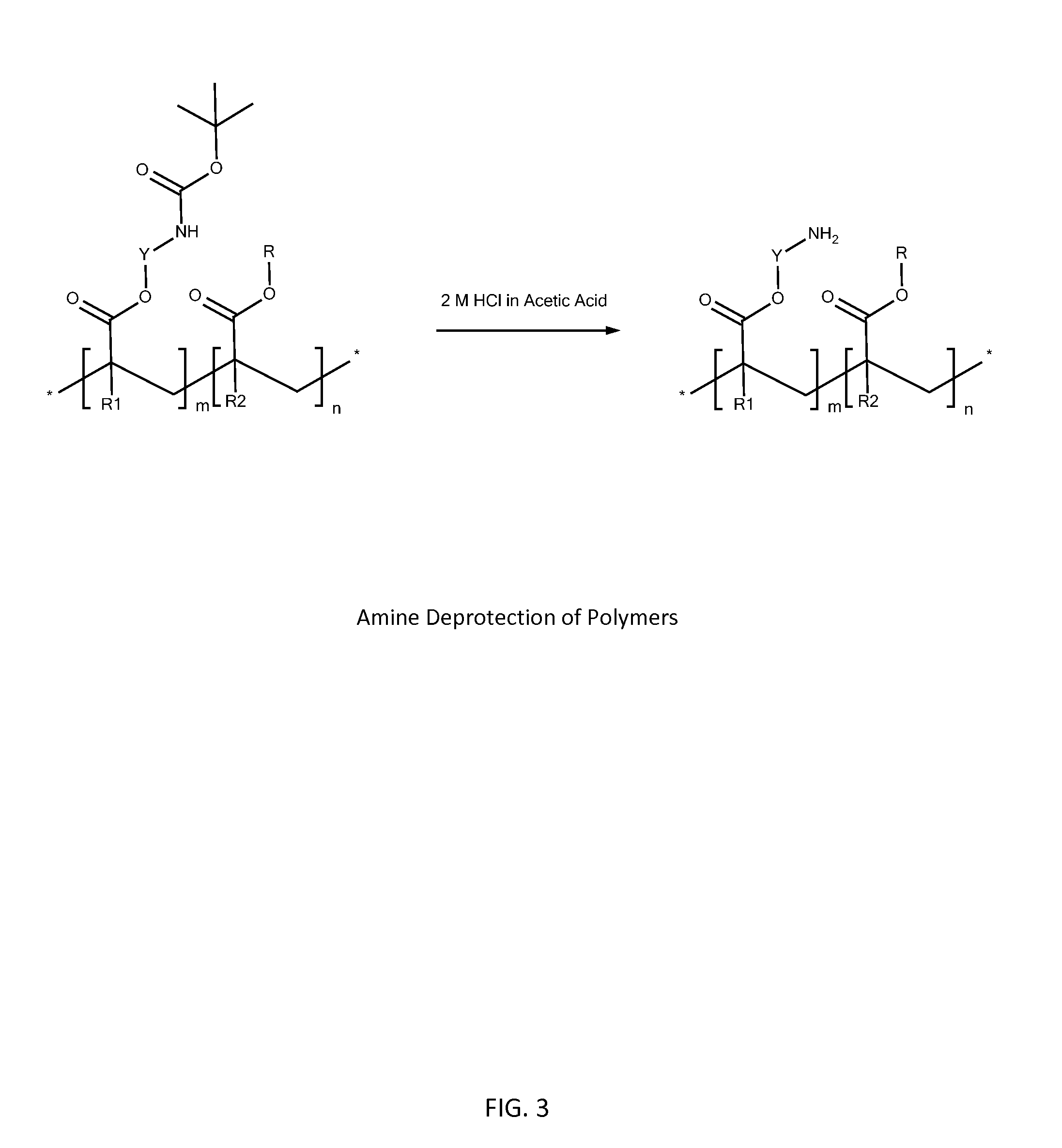Poly(acrylate) Polymers for In Vivo Nucleic Acid Delivery
- Summary
- Abstract
- Description
- Claims
- Application Information
AI Technical Summary
Benefits of technology
Problems solved by technology
Method used
Image
Examples
example 1
Amphipathic Poly(Acrylate) Random Copolymer Synthesis—General RAFT Procedure
[0182]A. Reversible Addition-Fragmentation Chain Transfer (RAFT) Polymerization
[0183]were performed to synthesize a series of random (meth)acrylate copolymers. RAFT polymerizations are described in Shipp D A and Malepu V “RAFT Polymerization of Vinyl Acetate, Styrene and Acrylates Using N,N Dithiocarbamates,” In Controlled / Living Radical Polymerization: Progress in RAFT, DT, NMP, and OMRP; Matyjaszewski, K.; ACS Symposium Series 1024; American Chemical Society: Washington, D.C., 2009; pp 37-47].
[0184]B. Polymer Calculations: Polymer Theoretical Molecular Weight (Mn, th), Moles Monomers, Moles Chain Transfer Agent, Moles Initiator.
[0185]General reaction for synthesis of polymer P from monomers A and B
[0186]A=Hydrophilic Monomer[0187]B=Hydrophobic Monomer[0188]P=Polymer[0189]C=Chain Transfer Agent (CTA)[0190]I=Initiator
[0191]Calculation of monomer average molecular weight for polymer P
[% A×MWA]+[% B×MWB]= MWAB...
example 2
Amphipathic Poly(Acrylate) Random Copolymer Synthesis
[0212]A. Polymer LAU 41648-140-B-fr1.
[0213]1. Amine-Protected LAU 41648-140-B-fr1 Poly(Acrylate) Random Copolymer Synthesis.
[0214]A solution of 2,2′-azobis(2-methylpropionitrile) (AIBN, CAS 78-67-1) was prepared at 1 mg / ml in butyl acetate. A separate solution of 4-cyano-4(phenylcarbonothioylthio)pentanoic acid (CPCPA, CAS 201611-92-9) was prepared at 10 mg / ml in butyl acetate. 2-(2-Boc-aminoethoxy)ethyl acrylate (BAEEA) (1.053 g, 4.059 mmol), propyl methacrylate (CAS 2210-28-8, 0.197 g, 1.54 mmol), CPCPA solution (0.700 mL, 0.0250 mmol), AIBN solution (0.616 mL, 0.00375 mmol), and butyl acetate (4.70 mL) were added to a 20 mL glass vial with stir bar. Monomer molar feed ratio was 72.5:27.5. Theoretical Mw was 50,000. The vial was sealed with a rubber cap and the solution bubbled with nitrogen using a long syringe with a second syringe as the outlet for 1 h. The syringes were removed and the vial heated to 80° C. for 15 h using an...
example 3
Amphipathic Poly(Acrylate) Random Copolymer Synthesis—Non-RAFT Polymerization
[0261]A. Polymer LAU 41305-38-17-19 Random Polyacrylate.
[0262]1. Synthesis of N-Boc-Amino-Propyl-Acrylate (BAPA).
[0263]In a 500 ml round bottom flask equipped with a stir bar and flushed with argon, 3-(BOC-amino)1-propanol (TCI) (135.8 mmol) was added, followed by 240 mL anhydrous dichloromethane. Diisopropylethyl amine (203.7 mmol) was added, and the system was placed in a dry ice / acetone bath. Acryloyl Chloride (149.4 mmol) was diluted using 10 ml of dichloromethane, and added drop-wise to the argon flushed system. The system was kept under argon and left to come to room temperature and stirred overnight. The product was washed with 100 mL each of dH2O, 10% citric acid, 10% K2CO3, sat. NaHCO3, and saturated NaCl. The product, BOC-amino propyl acrylate (BAPA), was dried over Na2SO4, gravity filtered, and DCM was evaporated using rotary evaporation. The product was purified through column chromatography on ...
PUM
| Property | Measurement | Unit |
|---|---|---|
| Fraction | aaaaa | aaaaa |
| Interference | aaaaa | aaaaa |
| Gene expression profile | aaaaa | aaaaa |
Abstract
Description
Claims
Application Information
 Login to View More
Login to View More - R&D
- Intellectual Property
- Life Sciences
- Materials
- Tech Scout
- Unparalleled Data Quality
- Higher Quality Content
- 60% Fewer Hallucinations
Browse by: Latest US Patents, China's latest patents, Technical Efficacy Thesaurus, Application Domain, Technology Topic, Popular Technical Reports.
© 2025 PatSnap. All rights reserved.Legal|Privacy policy|Modern Slavery Act Transparency Statement|Sitemap|About US| Contact US: help@patsnap.com



